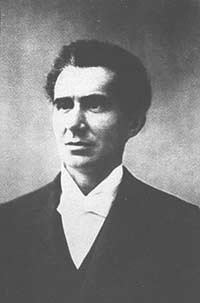Emile Berliner
- Birthdate
- 1851/05/20
- Birthplace
- Hanover, Germany
- Death date
- 1929/08/03
- Associated organizations
- Berliner Gramophone Company
- Fields of study
- Audio recording
Biography
Emile Berliner was born in Hanover, Germany, on 20 May 1851. He was the fourth child of a Jewish merchant family of eleven. His formal education ended at age 14. In 1870 he sailed for the United States where family friends found him work as a store clerk in Washington, D.C. The young immigrant was insatiably curious and thirsted for knowledge. In 1875 Berliner managed to get a position at the laboratory of Dr. Constantine Fahlberg, discoverer of saccharine, while also taking classes at a nearby university. He soon, however, returned to the store clerk’s position.
In the 1870s Alexander Graham Bell’s invention of the telephone was making a big splash, and Berliner decided to experiment in this field. By 1877 he perfected a new sort of telephone “transmitter”—what is today called a microphone. Unfortunately, Thomas Edison had invented almost the same thing simultaneously, and the two would engage in a lengthy patent battle over it. However, Bell learned of the invention, and in 1878 he hired Berliner to work with him in Boston.
In the 1880s Berliner turned his attention to record players. In 1887, he patented the gramophone system to compete with Edison's phonograph and the other cylinder machines that were beginning to be invented. Berliner chose to use a disc record instead of a cylinder because he intended to sell recordings along with the player. He devised an efficient method for duplicating the discs that would allow them to be mass-produced. Berliner ran his Gramophone Company (with manufacturing facilities located in Camden, New Jersey) for several years, and then merged it with another company owned by Eldridge Johnson to form the Victor Talking Machine Company in 1901. Victor emerged as a giant in both the manufacturer of gramophones and records. However, by the mid-1920s the company was in sharp decline. In 1926, Johnson arranged for the sale of Victor stock (including that held by Berliner) to a group of bankers, who in turn sold the company in 1929 to RCA. The RCA-Victor record label continues to the present day.
Berliner’s career as an inventor did not stop with the gramophone. In 1908 he developed a radial aircraft engine, followed by a functional helicopter in 1919. In 1925 he invented acoustic tiles for dampening sound.
Berliner also had a rich personal life. In 1881 he married Cora Adler. The Berliners eventually had six children. Berliner was also known as a progressive philanthropist. Special interests included supporting women’s involvement in science and advocating the pasteurization of milk. He died in Washington, D.C., on 3 August 1929.
